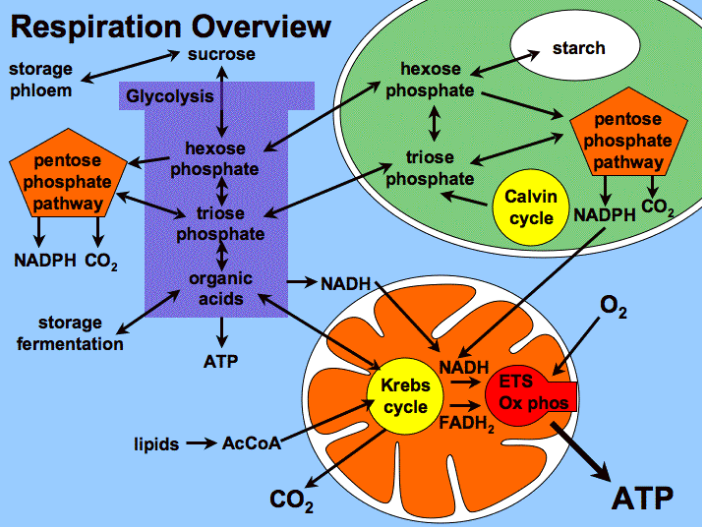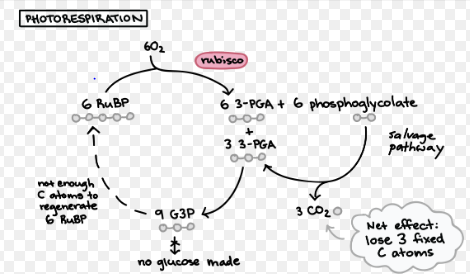What Is Respiration?
Respiration can also be referred to as Normal respiration or dark respiration is a set of metabolic reactions and processes that take place in the cells of organisms to convert biochemical energy from nutrients into adenosine triphosphate (ATP) and the release the metabolic waste products. The mitochondria found in the cell cytoplasm are where most respiration happens. Respiration occurs in four stages known as glycolysis, Link reaction, the Krebs cycle (citric acid cycle) and the electron transport chain. The end products of respiration are CO2 and water.
There are two types of respiration:
- Aerobic respiration, which requires oxygen and releases lots of oxygen.
- Anaerobic respiration, which does not require oxygen but releases much less energy per mole of starting material.

What Is Photorespiration?
Photorespiration also referred to as the oxidative photosynthetic carbon cycle, is a process in plant metabolism where the enzyme RuBisCO oxygenates RuBP, wasting some of the energy produced by photosynthesis. Photorespiration occurs under high light intensities and involves a complex network of enzyme reactions that exchange metabolites between chloroplasts, leaf peroxisomes and mitochondria.

Contrary to the process of Normal respiration, photorespiration does not produce any ATP. In C3 plants, this process has been shown to lower the overall rate of photosynthesis. On the other hand, in C4 plants, photorespiration has quite a negligible effect. The end products of photorespiration are CO2 and PGA.
Also Read: Difference Between Cellular Respiration And Photosynthesis
Normal Respiration Vs. Photorespiration In Tabular Form
| BASIS OF COMPARISON | NORMAL RESPIRATION | PHOTORESPIRATION |
| Description | Normal respiration is a metabolic pathway which releases energy-rich molecules by the breakdown of sugar molecules such as glucose. | Photorespiration is a type of respiration which occurs in plants in presence of light and at high oxygen concentration. |
| Alternative Names | Respiration can also be referred to as Normal respiration or dark respiration. | Photorespiration can also be referred to as dark respiration. |
| Occurrence | Normal respiration takes place in both in presence of light and dark. | Photorespiration only takes place in the presence of light. |
| Substrate | The substrate for normal respiration is commonly glucose though other food materials (fat, protein, organic acids) can also be used. | The substrate for photorespiration is RuBP and its breakdown product is glycolate. |
| Organelles of Occurrence | Normal respiration is completed in cytoplasm and mitochondria. | Photorespiration is completed in three organelles chloroplasts, Mitochondria and Peroxisomes. |
| Saturation Point | The saturation point is atteined at relatively lower concentrations of oxygen. | The saturation point is attained at relatively high oxygen concentration. |
| Involves | Aerobic respiration is completed in Glycolysis, Krebs Cyle and Electron Transport System. | Photorespiration does not involve Electron Transport System (ETS), Krebs cycle and Glycolysis. |
| Occurrence | Normal respiration takes place in both green and non green cells. | Photorespiration takes place only in green photosynthesizing cells. |
| Effect of Oxygen Concentration | Respiration is not influenced by change in oxygen concentration between 10-25%. Beyond it there is a decline in the rate of respiration. | Photorespiration increases with increase in availability of oxygen. |
| Production of Energy-Rich Molecules | Normal respiration produces energy-rich molecules such as ATP, GTP, NADH2 and FADH2. | Photorespiration does not produce energy-rich molecules such as ATP. |
| End Products | The end products of respiration are CO2 and water. | The end products of photorespiration are CO2 and PGA. |
| Nature | Respiration is an energy producing process. It produces usable energy in the form of ATP. | Photorespiration is an energy wastage process. It does not produce any usable energy in the form of ATP. |
| Hydrogen Peroxide | During normal respiration hydrogen peroxide is not produced. | Toxic hydrogen peroxide may be formed during oxidation of the substrate. |
| Importance | Normal or dark respiration is essential for survival of organisms. | Photorespiration is not essential to the survival of organisms. |
| End Product Recycling | The end products of respiration may or may not be reutilized by photosynthesis. | Both the end products of photorespiration are reutilized in photosynthesis. |
| Substrate Formation | The substrate is already present in the cells. | The substrate is formed at the time of utilization. |
| Phosphorylation | Oxdative Phosphorylation takes place. | Phosphorylation does not take place. |
| Ammonia Production | No single molecule of Ammonia (NH3) is produced. | One molecule of ammonia (NH3) is produced. |
What Are Some Of The Similarities Between Respiration And Photorespiration?
- Both respiration and photorespiration uses oxygen.
- Both are catabolic processes.
- Both respiration and photorespiration produce carbon dioxide as the end product.
- Both involve enzymes in their reactions as catalysts.
- Photorespiration and respiration occurs in green plants.
Also Read: Difference Between Aerobic And Anaerobic Respiration